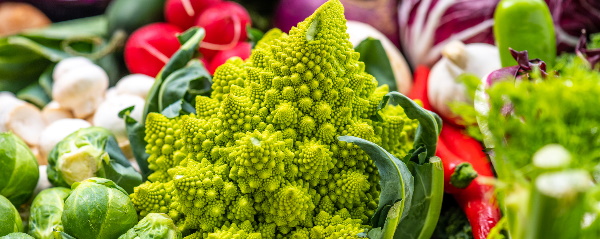Which is healthier, broccoli or cauliflower?
Broccoli and cauliflower are comparable in many respects as both have similar amounts of carbs, fibre and protein. On the nutrient front, broccoli is slightly healthier, although cauliflower contains more folate and potassium. Both should be consumed regularly as they contain a slightly different balance of nutrients, antioxidants and phytonutrients and are extremely healthy options.
5 health differences between broccoli and cauliflower
Some of the main health differences between broccoli and cauliflower are as follows:
1. Broccoli is higher in some nutrients
On a tit for tat nutrient basis, broccoli may fair slightly better (perhaps the vibrant green colour is a giveaway), but let's not criticise cauliflower until after my next point on this list!
Now, back to broccoli, it contains marginally more vitamin C, vitamin K, phosphorus, vitamin E and magnesium per serving than its neutral-coloured cousin. However, we're talking as little as 1% difference per portion, in some cases. Plus, as is typical of many vegetables, they both contain at least a little of an extremely wide spectrum of nutrients.
2. Cauliflower offers other additional, nutrients
However, cauliflower can still give broccoli a good run for its money in the nutrient department. Cauliflower contains more B vitamins compared to broccoli, including vitamin B5, vitamin B6 and folate. It also contains the all-important potassium which has a whole host of benefits for our nervous and cardiovascular systems.
Whilst cauliflower doesn't have quite as much vitamin C as broccoli, it still contains over 50% of the recommended daily amount per serving, meaning that you shouldn't struggle too hard to hit your quota elsewhere, after including some of this humble veg just once daily.
3. Both boast plenty of antioxidants, just some different varieties
Regardless of some of the more minor nutritional differences, broccoli and cauliflower come from the same family of vegetables. You might have heard the term 'cruciferous' vegetables, which they are. They are also often classed as coming from the 'Cole' family of vegetables and are actually variations of the wild mustard plant, also known as the wild cabbage plant. This family heritage gives rise to their characteristic bitter taste, although cauliflower is a much subtler version.
However, regardless of some of their differences, many of the nutrients they contain are comparable, which means they often get grouped together when it comes to nutritional research. Once study, in particular, highlighted nicely that cruciferous veg intake was inversely related to blood vessel calcification or hardening in elderly subjects. This means that the more you eat, the better state your blood vessels are likely to be in. (1)
These health benefits are likely to be down to the lovely array of nutrients we've already explored. The fibre content is also likely to be having a positive influence, as we'll go on to probe a little further, plus, crucially, some unique antioxidants such as glucosinolates have positives to offer.
These unique sulphur-containing compounds are extremely beneficial and, whilst cauliflower arguably has a slightly more impressive profile than broccoli, the health benefits of both are clear. (2)
4. Fibre and protein levels
Broccoli contains marginally more protein and fibre per serving than cauliflower, but only 0.5g per serving. That is approximately 2g vs 2.5g for both, respectively.
However, if you're worried about losing that half gram of fibre, then my advice is to save the stems of your cauliflower. Just like broccoli, these are perfectly edible and I always save them and use them in the bases and stocks of soups or stews. Simply cut them into cubes and then fry in some extra virgin olive oil, and then simmer gently until cooked through – delicious, filling, you're helping to reduce food waste by using them in this way. Plus, as we know now, they are extremely healthy as well!
5. Cauliflower is more versatile
Whilst broccoli arguably comes up higher in the popularity stakes (or is this only in the toddler world as they resemble small tress and therefore achieve the upmost respect?), I'm here to try and change that slightly. If you've only ever had cauliflower cheese, then you're missing out and there's much more to this exciting vegetable than meets the eye.
The delicate florets of cauliflower are extremely accepting and wanting of flavour and will happily soak up any delicious offerings you give them. This means they can work very well alongside spices, such as in curries, aromatic stews or my latest recipe: Spicy Roast Cauliflower.
Although I may be biased here, I feel this one really allows the vegetable to come into its own, and it makes for a striking side dish. Check out my latest recipe, Roasted and Spiced Caulflower:
Further to this, cauliflower can become more than a side dish of florets that we all know and love. Did you know, for example, that it can be blitzed up and used as an alternative to flour and other grains in order to be baked, boiled, or steamed into some new forms? Think cauliflower rice, gnocchi or bread – who knew! See below for some more inspiration:
• Cauliflower pizza
• Veggie sushi with cauliflower rice
• Cauliflower curry
• Creamy cauliflower and broccoli soup
Ultimately, variety is key
 As with anything, although one item may be considered 'slightly healthier' than the next thing, in most cases, I'd say to you to include a little of both of them anyway, as the wider spectrum of nutrients we can include, the better, especially when it comes to vegetables!
As with anything, although one item may be considered 'slightly healthier' than the next thing, in most cases, I'd say to you to include a little of both of them anyway, as the wider spectrum of nutrients we can include, the better, especially when it comes to vegetables!
Your gut health, for one, will thank you for it. We know that a wide variety of different types of dietary fibre will help translate into a wider spectrum of good gut bacteria, plus, from a practical point of view, it keeps your plate ever-changing and exciting!
When it comes to the broccoli vs. cauliflower conundrum, I have the perfect solution: Broccoflower. Yes, it's also known as Romanesco cauliflower and is a beautiful hybrid of the two. Best of both worlds, perhaps? Well, by all means include this too, but I'd urge you to include them all, equally, and reap those benefits.





 Looking to support your immune system? Well, look no further!
Looking to support your immune system? Well, look no further!
